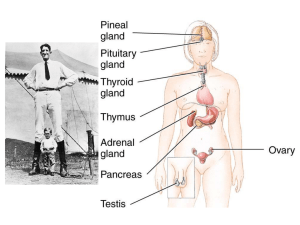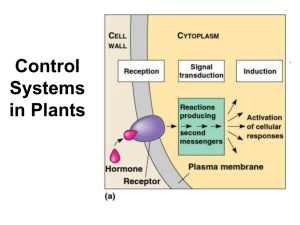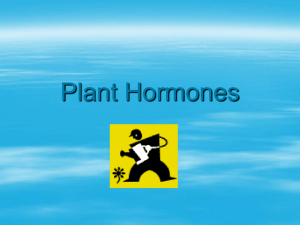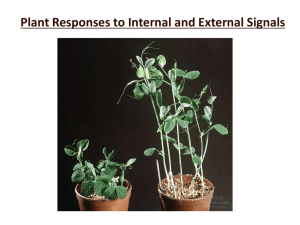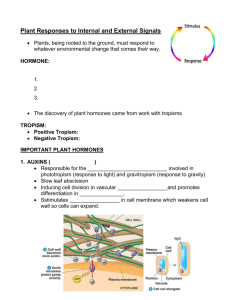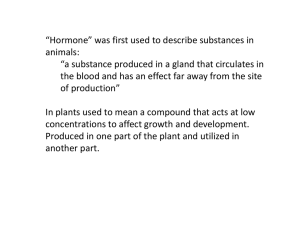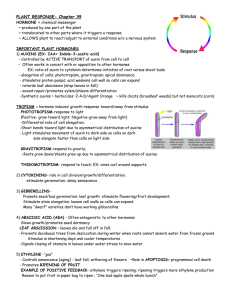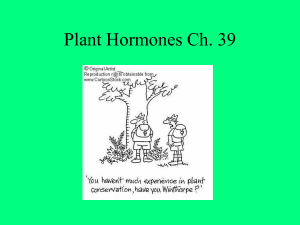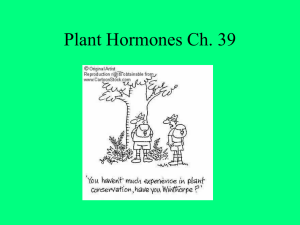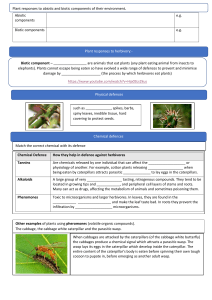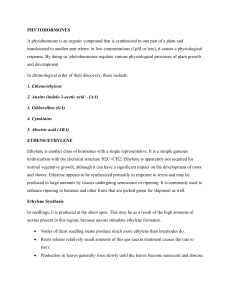Plant Biology Assignment: Hormones, Growth, and Defense
advertisement
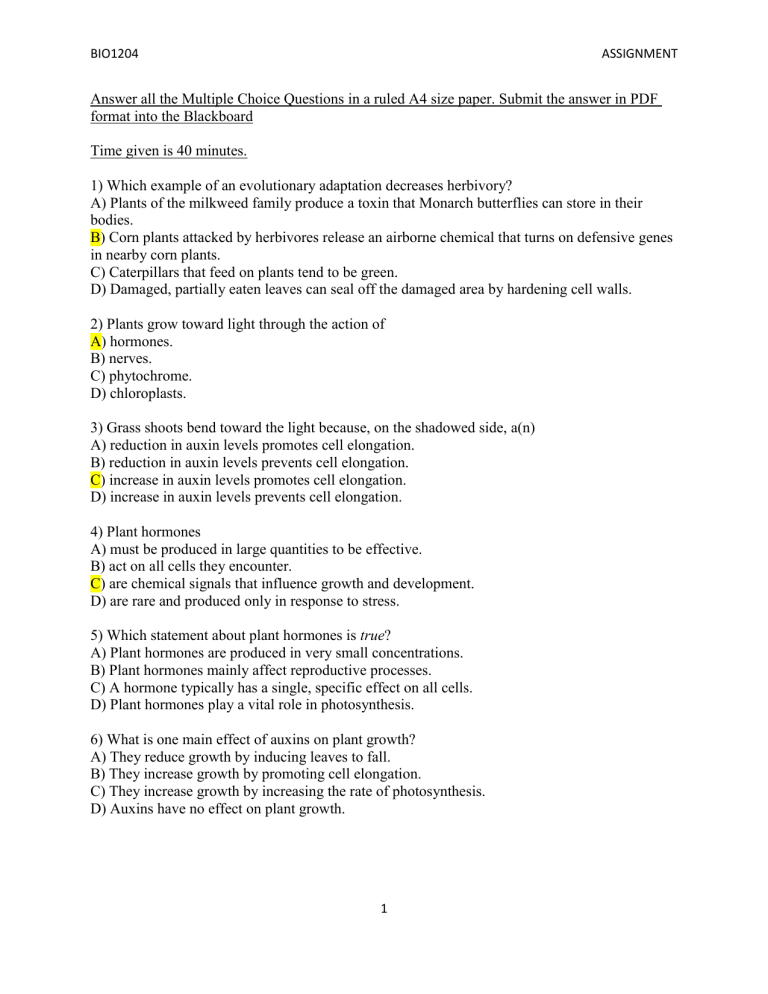
BIO1204 ASSIGNMENT Answer all the Multiple Choice Questions in a ruled A4 size paper. Submit the answer in PDF format into the Blackboard Time given is 40 minutes. 1) Which example of an evolutionary adaptation decreases herbivory? A) Plants of the milkweed family produce a toxin that Monarch butterflies can store in their bodies. B) Corn plants attacked by herbivores release an airborne chemical that turns on defensive genes in nearby corn plants. C) Caterpillars that feed on plants tend to be green. D) Damaged, partially eaten leaves can seal off the damaged area by hardening cell walls. 2) Plants grow toward light through the action of A) hormones. B) nerves. C) phytochrome. D) chloroplasts. 3) Grass shoots bend toward the light because, on the shadowed side, a(n) A) reduction in auxin levels promotes cell elongation. B) reduction in auxin levels prevents cell elongation. C) increase in auxin levels promotes cell elongation. D) increase in auxin levels prevents cell elongation. 4) Plant hormones A) must be produced in large quantities to be effective. B) act on all cells they encounter. C) are chemical signals that influence growth and development. D) are rare and produced only in response to stress. 5) Which statement about plant hormones is true? A) Plant hormones are produced in very small concentrations. B) Plant hormones mainly affect reproductive processes. C) A hormone typically has a single, specific effect on all cells. D) Plant hormones play a vital role in photosynthesis. 6) What is one main effect of auxins on plant growth? A) They reduce growth by inducing leaves to fall. B) They increase growth by promoting cell elongation. C) They increase growth by increasing the rate of photosynthesis. D) Auxins have no effect on plant growth. 1 BIO1204 ASSIGNMENT 7) When a nursery worker pinches off the terminal buds on a young plant to make it grow bushy, which plant hormone, when produced, is mainly responsible for growth of side branches? A) an auxin B) a gibberellin C) a cytokinin D) abscisic acid (ABA) 8) Which class of hormones produced in the roots of plants promotes cell division and growth and retards the aging of flowers and leaves? A) gibberellins B) phytochromes C) cytokinins D) ethylene 9) The most reliable way to stimulate branching in a plant is to A) apply auxin to the roots. B) remove the terminal bud. C) give short-day light treatments. D) add extra fertilizer. 10) Shoot branching is controlled mainly by the interaction of A) auxins and gibberellins. B) auxins and cytokinins. C) gibberellins and cytokinins. D) cytokinins and abscisic acid. 11) The event that triggers fruit formation is the growth of a pollen tube through the carpel of a flower. Identify a reasonable hypothesis about the basis of this effect. A) Pollen tubes grow in response to a cytokinin produced by the carpel. B) Pollen tubes grow in response to abscisic acid. C) The growing pollen tube produces ethylene. D) The growing pollen tube produces auxins and/or gibberellins. 12) Which substance might induce seeds treated with it to break dormancy? A) an auxin B) a cytokinin C) a gibberellin D) ethylene 13) Fruit that forms on an unpollinated plant in response to a hormone will lack A) flavor. B) seeds. C) rind. D) naturally occurring hormones. 2 BIO1204 ASSIGNMENT 14) Bush beans grow as small bushes rather than as vines because their internodes are short and they branch close to the apical meristem. Which substance, if applied to a bush bean, might cause it to elongate its internodes and grow as a vine? A) a cytokinin B) a gibberellin C) abscisic acid (ABA) D) ethylene 15) Which substance induces "bolting," the rapid elongation of a plant stem? A) a gibberellin B) abscisic acid (ABA) C) ethylene D) phytochrome 16) Which type of plant hormone generally acts as a growth inhibitor? A) auxins B) gibberellins C) cytokinins D) abscisic acid (ABA) 17) Under what conditions would you expect a plant to have the highest concentration of abscisic acid (ABA)? A) wet tropical rain forest B) cool environment after a heavy rain C) houseplant growing in low light conditions D) desert after a long drought 18) In leaf abscission, the abscission layer forms where the A) leaf stalk joins the stem. B) axillary bud joins the stem. C) root joins the stem. D) leaf stalk joins the leaf. 19) Where might you put a green, unripe fruit to ripen it? A) a dark but well-ventilated area B) a sealed plastic bag with an overripe banana C) a microwave, on low power, for 5 minutes D) under a bright light for 24 hours 20) What is one adaptive advantage for deciduous plants that lose their leaves during the winter? A) It prevents water loss from leaves when soil water is unavailable due to freezing. B) Production of new leaves each spring uses less energy than supporting old leaves all winter. C) If leaves are damaged by frost, the tree will die. D) A layer of leaves on the ground helps keep plant roots warm. 3 BIO1204 ASSIGNMENT 21) Which list correctly orders the events leading to leaf fall in deciduous trees? A) formation of abscission layer, increase in ethylene levels, decrease in auxin levels B) shortening days, increase in ethylene production, formation of abscission layer C) shortening days, formation of abscission layer, decrease in ethylene levels D) decrease in ethylene levels, shortening days, formation of abscission layer 22) Which growth response causes the shoots of a plant grown in the dark to grow upward? A) phototropism B) thigmotropism C) gravitropism 23) The plant growth response to touch is known as A) gravitropism. B) geotropism. C) thigmotropism. 24) Which statement concerning biological clocks is false? A) Innate circadian rhythms are generally about 24 hours in length. B) Circadian rhythms occur with or without external stimuli. C) Biological clocks are strongly influenced by external temperatures. D) Movement of plants long distances very quickly induces a kind of plant "jet lag." 25) Which plant response is affected by photoperiod? A) gravitropism B) apical dominance C) onset of dormancy D) cell division 26) A plant will only flower if the night length is longer than 14 hours. This plant is a A) long-day plant. B) short-night plant. C) short-day plant. D) day-neutral plant. 27) Iris is a long-day plant that normally flowers in the spring. Which regimen would be the most effective in making an iris bloom in late fall? A) interrupting the plant's nights at 2:00 AM with a flash of far-red light B) interrupting the plant's nights at 2:00 AM with a flash of red light followed by a flash of farred light C) interrupting the plant's nights at 2:00 AM with a red flash, then a far-red flash, then a red flash D) interrupting the plant's days at 2:00 PM by putting it in the dark 4 BIO1204 ASSIGNMENT 28) How does phytochrome control flowering? A) by disrupting the plant's photoperiod B) by detecting differences in temperature in the spring C) by sensing sunrise and sunset D) by inducing differentiation of cells in the apical meristem 29) A plant's first line of defense against infection is A) cell elongation. B) its epidermis. C) phytochrome. D) salicylic acid. 30) What is one way that plants use animals as a defense against herbivores? A) production of an amino acid that harms herbivores B) attraction of wasps that kill herbivorous caterpillars C) release of microbe-killing chemicals in response to infection D) coevolution between plants and predators 5
